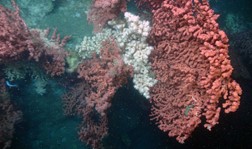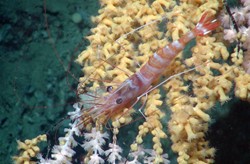Mid-Atlantic Canyons
 The continental shelf along the US east coast between North Carolina and New England is incised with several submerged canyons, some of which are very large. Although the muddy shelf between the canyons has been sampled extensively, the rugged slopes of the canyons cannot be easily sampled using traditional gear such as trawls and dredges. In 2010 the Atlantic Deepwater Canyons study was funded to explore and conduct research on these little known canyons, with particular emphasis on deep sea corals. This is a large multidisciplinary study involving many scientists studying physical oceanography, geology and various aspects of biology and ecology. The first step for the project was to make high resolution maps of our target study sites, which were Baltimore and Norfolk canyons. We then used the maps to guide remotely operated vehicles (ROV) to survey the canyons in search of coral habitats.
The continental shelf along the US east coast between North Carolina and New England is incised with several submerged canyons, some of which are very large. Although the muddy shelf between the canyons has been sampled extensively, the rugged slopes of the canyons cannot be easily sampled using traditional gear such as trawls and dredges. In 2010 the Atlantic Deepwater Canyons study was funded to explore and conduct research on these little known canyons, with particular emphasis on deep sea corals. This is a large multidisciplinary study involving many scientists studying physical oceanography, geology and various aspects of biology and ecology. The first step for the project was to make high resolution maps of our target study sites, which were Baltimore and Norfolk canyons. We then used the maps to guide remotely operated vehicles (ROV) to survey the canyons in search of coral habitats.  We found many more corals than we were expecting from the sparse historical information and discovered Lophelia pertusa for the first time in the mid-Atlantic region. Other stony corals included another branching coral (Solenosmilia variabilis) large clusters of the giant cockscomb coral (Desmophyllum dianthus) and the large cup coral Flabellum alabastrum, one of the few corals that lives in soft sediment. The rugged canyon walls are covered in huge colonies of bubblegum corals (Paragorgia arborea), red tree corals (Primnoa resedaeformis) and several other species of tree corals. Our lab is processing the samples using histological techniques to study the reproductive cycles of the corals and seep fauna. In addition, we are describing the habitats and community structure and correlating biological observations with physical data such as temperature, turbidity, dissolved oxygen and pH to see if we can identify those factors that are driving the observed community distributions.
We found many more corals than we were expecting from the sparse historical information and discovered Lophelia pertusa for the first time in the mid-Atlantic region. Other stony corals included another branching coral (Solenosmilia variabilis) large clusters of the giant cockscomb coral (Desmophyllum dianthus) and the large cup coral Flabellum alabastrum, one of the few corals that lives in soft sediment. The rugged canyon walls are covered in huge colonies of bubblegum corals (Paragorgia arborea), red tree corals (Primnoa resedaeformis) and several other species of tree corals. Our lab is processing the samples using histological techniques to study the reproductive cycles of the corals and seep fauna. In addition, we are describing the habitats and community structure and correlating biological observations with physical data such as temperature, turbidity, dissolved oxygen and pH to see if we can identify those factors that are driving the observed community distributions.

